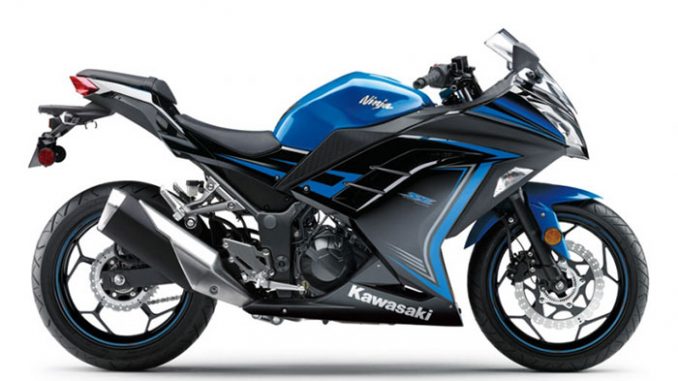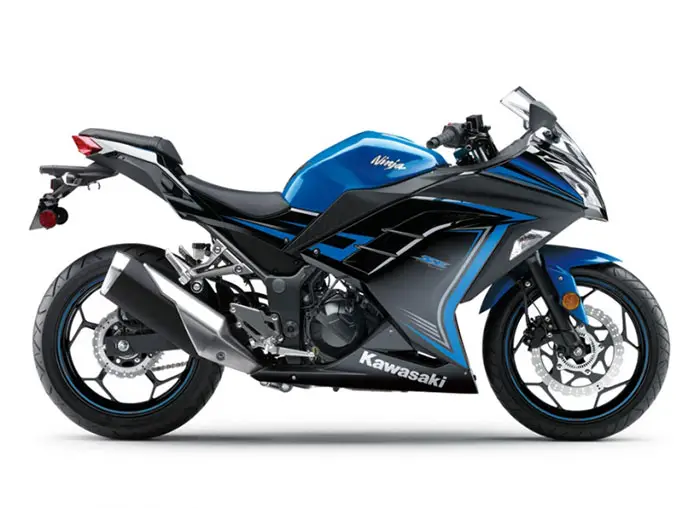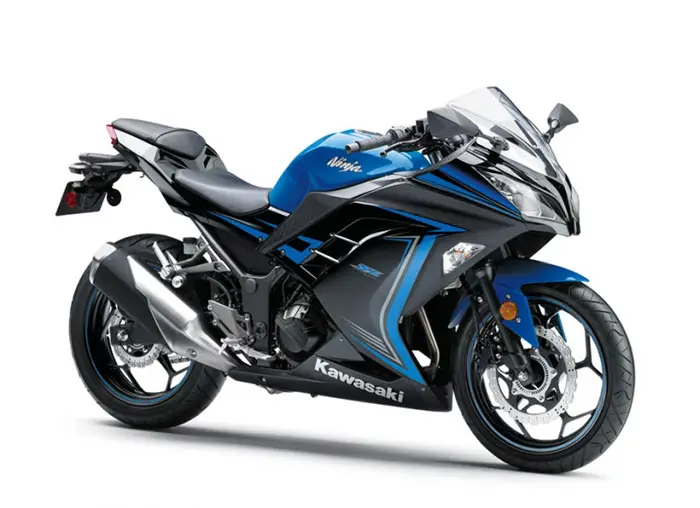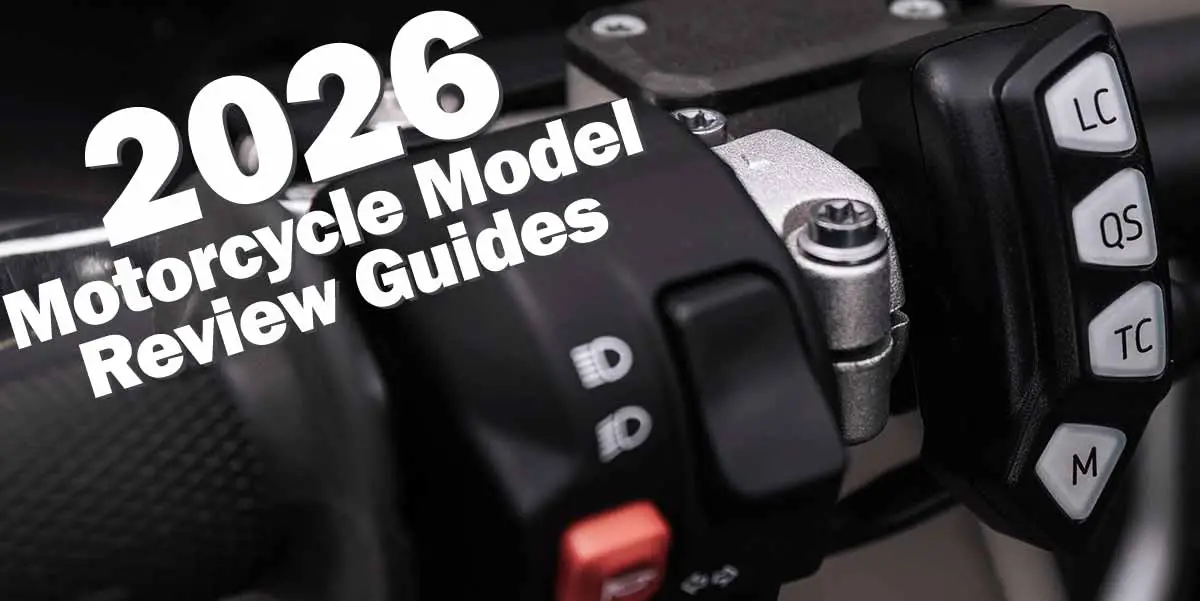
Back to 2015 Kawasaki Motorcycle Model Review Page
Click photos to enlarge. Our big, clean bike pics make great desktop wallpaper.

2015 Kawasaki Ninja 300 ABS SE ABS

2015 Kawasaki Ninja 300 ABS SE ABS

2015 Kawasaki Ninja 300 ABS SE ABS
2015 Kawasaki Ninja 300 ABS SE ABS Review
2015 Kawasaki Ninja 300 ABS SE ABS on www.Totalmotorcycle.com
A great starter Ninja
Whether referring to engine or chassis performance, or the latest available technology, the name “Ninja” implies the very best that Kawasaki has to offer. In the case of the all-new Ninja 300, it means a larger-displacement 296cc engine with the power and torque to eclipse everything in its class.
2015 Kawasaki Ninja 300 ABS SE ABS www.Totalmotorcycle.com Key Features
2015 Kawasaki Ninja 300 ABS SE ABS www.Totalmotorcycle.com Features and Benefits
Dual Throttle Valves
Late-model sport bikes often use large-bore throttle bodies to generate high levels of power. However, with large diameter throttles, when a rider suddenly opens the throttle, the unrestricted torque response is anything but gentle and often more than the rider can handle. Dual throttle valve technology was designed to tame engine response while contributing to performance.
On fuel-injected models, throttle bodies generally have only one throttle valve per cylinder. On models with dual throttle valves, there are two throttle valves per cylinder: in addition to the main valves, which are physically linked to the throttle grip and controlled by the rider, a second set of valves, opened and closed by the ECU, precisely regulates intake airflow to ensure a natural, linear response. With the air passing through the throttle bodies becoming smoother, combustion efficiency in improved and power is increased.
Like other Kawasaki engine management technology, Dual Throttle Valves were designed with the philosophy of “following the rider’s intention, while providing natural-feeling support.” They are featured on many Kawasaki models.
Assist & Slipper Clutch
Based on feedback from racing activities, the Assist & Slipper Clutch uses two types of cams (an assist cam and a slipper cam) to either drive the clutch hub and operating plate together or apart.
Under normal operation, the assist cam functions as a self-servo mechanism, pulling the clutch hub and operating plate together to compress the clutch plates. This allows the total clutch spring load to be reduced, resulting in a lighter clutch lever feel when operating the clutch.
When excessive engine braking occurs – as a result of quick downshifts (or an accidental downshift) – the slipper cam comes into play, forcing the clutch hub and operating plate apart. This relieves pressure on the clutch plates to reduce back-torque and help prevent the rear tyre from hopping and skidding.
ABS
Sudden over-application of the brakes, or braking on low-grip surfaces (surfaces with a low coefficient of friction) such as wet asphalt or manhole covers may cause a motorcycle’s wheel(s) to lock up and slip. ABS was developed to prevent such incidents. Kawasaki ABS systems are controlled by high precision and highly reliable programming formulated based on thorough testing of numerous riding situations. By ensuring stable braking performance, they offer rider reassurance that contributes to greater riding enjoyment.
And to meet the special requirements of certain riders, specialised ABS systems are also available. For example, KIBS (Kawasaki Intelligent anti-lock Brake System) is a high-precision brake system designed specifically for supersport models, enabling sport riding to be enjoyed by a wider range of riders. And by linking the front and rear brakes, K-ACT (Kawasaki Advanced Coactive-braking Technology) ABS provides the confidence to enjoy touring on heavyweight models. Kawasaki is continually working on the development of other advanced ABS systems.
Economical Riding Indicator
Using high-precision electronic control for engine management, Kawasaki models can achieve a high level of fuel efficiency. However, fuel consumption is greatly affected by throttle use, gear selection, and other elements under the rider’s control. The Economical Riding Indicator is a function that indicates when current riding conditions are consuming a low amount of fuel. The system continuously monitors fuel consumption, regardless of vehicle speed, engine speed, throttle position and other riding conditions. When fuel consumption is low for a given speed (i.e. fuel efficiency is high), an “ECO” mark appears on the instrument panel’s LCD screen. By riding so that the “ECO” mark remains on, fuel consumption can be reduced.
While effective vehicle speed and engine speed may vary by model, paying attention to conditions that cause the “ECO” mark to appear can help riders improve their fuel efficiency – a handy way to increase cruising range. Further, keeping fuel consumption low also helps minimise negative impact on the environment.
2015 Kawasaki Ninja 300 ABS SE ABS – www.Totalmotorcycle.com USA Specifications/Technical Details
US MSRP Price: $NA USD
Model not available
2015 Kawasaki Ninja 300 ABS SE ABS – www.Totalmotorcycle.com Canadian Specifications/Technical Details
Canada MSRP Price: $5,999 CDN
Engine
Type 4-stroke Parallel Twin
Displacement 296cc
Bore and stroke 62.0 x 49.0 mm
Compression ratio 10.6:1
Valve system DOHC, 8 valves
Fuel system Fuel Injection: 32mm x 2 (Keihin)
Ignition Digital
Lubrication Forced Lubrication, wet sump
Cooling Liquid-cooled
Brakes
Front: type Single 290 mm petal disc
Front: calipers Single balanced actuation dual-piston
Rear: type Single 220mm petal disc
Rear: calipers Dual-piston
Dimensions
Overall length 2,015mm
Overall width 715mm
Overall height 1,110mm
Wheelbase 1,405mm
Seat height 785mm
Curb mass** 174kg
Fuel capacity 17 litres
Ground clearance 140mm
Drivetrain
Transmission 6-speed, return
Final drive Seeled chain
Primary reduction ratio 3.087 (71/23)
Gear ratio: 1st 2.714 (38/14)
Gear ratio: 2nd 1.789 (34/19)
Gear ratio: 3rd 1.409 (31/22)
Gear ratio: 4th 1.160 (29/25)
Gear ratio: 5th 1.000 (27/27)
Gear ratio: 6th .857 (24/28)
Final reduction ratio 3.000 (42/14)
Clutch Wet multi-disc, manual
Frame
Type Tube diamond,steel
Wheel travel: front 120mm
Wheel travel: rear 132mm
Tire: front 110/70-17 M/C 54S
Tire: rear 140/70-17 M/C 66S
Caster (rake) 27°
Trail 93mm
Steering angle (left/right) 35° / 35°
Performance
Maximum Power‡ 29.0 kW {39PS} / 11,000
Maximum Torque‡ 27.0 N·m {2.8 kgf·m} / 10,000 rpm
Suspension
Suspension, front 37mm telescopic fork
Suspension, rear Bottom-Link Uni-Trak with gas charged shock and 5-way adjustable preload
* The Manufacturer’s Suggested Retail Price does not include freight, pre-delivery inspection or applicable taxes. The final price is at the discretion of the dealer. Prices and Specifications are subject to change without prior notice. The amount indicated as “Your price” may include an optional instant Mega Cash credit that is deducted from the manufacturer’s suggested retail price before taxes. This promotion is time limited and certain conditions will apply. See your dealer for complete details. Offer not available on financed purchases and cannot be combined with any other special offers. The final price is at the discretion of the dealer. Prices and Specifications are subject to change without prior notice.
** Includes all necessary materials and fluids to operate correctly, full tank of fuel (more than 90% of capacity) and tool kit (if supplied)
‡ Power / Torque figures measured at the crankshaft.
The specifications mentioned here apply to and have been achieved by production models under standard operating conditions. We intend only to give a fair description of the vehicle and its performance capabilities but these specifications may not apply to every machine supplied for sale. Kawasaki Heavy Industries, Ltd. reserves the right to alter specifications without prior notice. Equipment illustrated and specifications may vary to meet individual markets. Available colours may vary by market.



Be the first to comment